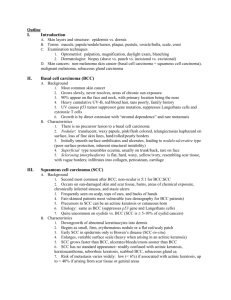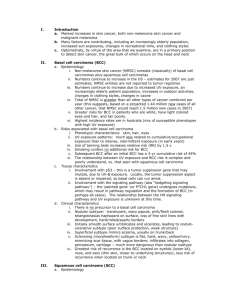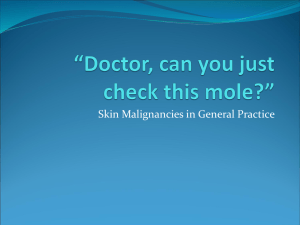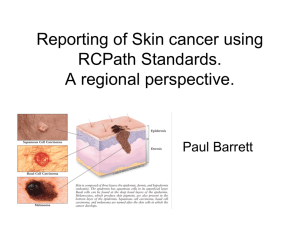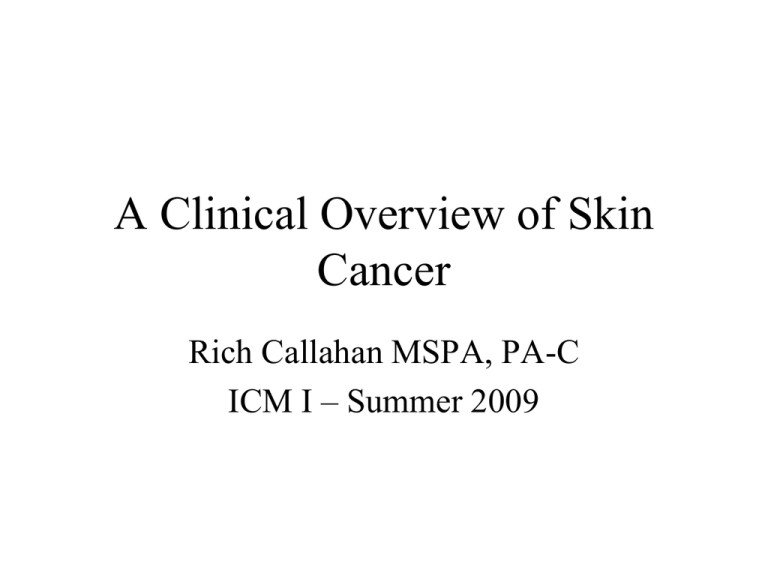
A Clinical Overview of Skin
Cancer
Rich Callahan MSPA, PA-C
ICM I – Summer 2009
Recognition and treatment of skin cancer will only
become more important for those going into primary
care, geriatrics and dermatology
• You will see it often in your career.
• By far the most common cancer, and one of the few whose
incidence is still increasing dramatically.
• Incidence generally increases with age – our aging
population structure will ensure a steady supply of cases
over time.
• Goal is prevention and early recognition. A small skin
cancer diagnosed early will generally create much less
overall morbidity than a larger skin cancer diagnosed late.
Incidence and Epidemiology
(From www.aad.org)
•
•
•
•
•
Approximately 1.2 million cases this year.
80% Basal Cell Carcinoma (BCC)
16% Squamous Cell Carcinoma (SCC)
4% Malignant Melanoma (MM)
<1% are the extremely rare skin cancers: Desmoplastic
melanoma, eccrine porocarcinoma, cutaneous T-Cell
lymphoma (CTCL,) sebaceous gland carcinoma, Kaposi’s
sarcoma, leukemia cutis, angiosarcoma, etc.
• We will focus on the big 3 because you will see these in
clinical practice.
Skin Cancer – The Big 3
• BCC: The most common and least aggressive skin cancer. Slowly
growing with low potential to metastasize and/or invade underlying
structures. Lesions can be subtle and insidious, infiltrating large areas
before they are discovered. Huge range of potential presentations.
• SCC: 2nd most common skin cancer. More aggressive than BCC, with
higher potential to invade underlying structures if not treated promptly.
Usually, it is the most advanced cases that metastasize, but lesions on
the lip, nose and ear will do it earlier and must be recognized! Actinic
Keratosis (AK) is a precursor lesion to SCC.
• BCC/SCC referred to collectively as non-melanoma skin cancer, or
NMSC, which accounts for approx. 2,200 deaths/year and huge
surgical morbidity.
Breakdown of the big 3 into subtypes
• BCC: Nodular, infiltrative, superficial,
morpheaform (sclerosing,) and
fibroepithelioma of Pinkus.
• SCC: Invasive, SCC in situ (Bowen’s
Disease.)
• MM: MM in situ, superficial spreading,
nodular, amelanotic and lentigo maligna.
Epidemiology/Risk Factors for NMSC
• People at highest risk:
• Fair skin (Fitzpatrick I or II,) and history of excessive,
unprotected sun exposure/sun burns.
• Family history of one or more 1st degree relatives with skin
cancer (a strong predictor.)
• Immune compromise: Can see elderly patients suddenly
develop crops of skin cancers as their immune function
declines. Also seen in organ transplant recipients (OTR’s)
who have several risk factors for skin cancer and who are
on strong immunosuppressive drugs to prevent organ
transplant rejection.
Fitzpatrick’s Skin Phototypes
• Type 1: Fair skinned. Always burn (even short exposure
time of <30 min.,) never tan.
• Type 2: Fair skinned. Often burn, tans with great
difficulty.
• Type 3: Some sunburn at first, but then tan deeply.
• Type 4: Never burns, tans with ease.
• Types 5-6: Darker skin types which burn only under the
most extreme, prolonged exposures.
Malignant Melanoma (MM)
Least common of the big three (approx. 56,000 cases/year)
but accounts for large majority of skin cancer mortality
(approx. 7,700 deaths/year.) Incidence of MM increasing
alarmingly in certain groups:
#1 cause of cancer death in women 25-30 y/o
#2 cause of cancer death in women 30-35 y/o after Breast Ca
Quickly becoming a leading cause of cancer death in men 3545 y/o
One AAD publication stated that incidence of MM has
increased 7000% since the 1920’s in the U.S.
MM
• High cure rate when caught early, but terrible prognosis if
it has already started to spread when diagnosed.
• Prognosis based on depth of lesion at time of diagnosis.
• Deeper tumor = higher chance for metastasis
• Metastatic melanoma has high rate of mortality over a 5
year period after diagnosis.
• Many chemotherapeutic and immune-stimulating therapies
have been tried in treatment, with poor results so far.
• Our best defense is early detection.
Risk Factors for MM
• Fair skin (Fitz I/II,) blue eyes, red hair, freckles.
• History of severe, intermittent sun exposure rather than
gradual (think Vermonter going to St. Croix in January.)
• History of severe, blistering sun burns before the age of 18.
• Presence of dysplastic nevus syndrome
• Family history of MM, especially 1st degree relatives who
got it young (i.e., in their 30’s/40’s,) as this suggests a
genetic vulnerability.
• Prior personal history of MM
Why the big increase in MM?
• Demographic trends: Over time we have become a more
prosperous, mobile society with more free time to sit in the
sun and travel to warm climates. The tan look has become
synonymous with vitality, well-being and sex appeal.
• Clothing: Since the beginning of the 20th century, our
culture has trended towards wearing less clothing in public
(100 years ago common modesty dictated that you went
swimming almost fully clothed, now we have bikini
thongs.)
• Tanning Beds: Depending on which study you look at,
emit between 2-15 times more UV radiation than the sun!
The Single Greatest Risk Factor
for Skin Cancer?
• Prior personal history of Skin Cancer.
• A patient with a past history has a much greater risk for
developing additional skin cancers when compared to the
general population.
• For this reason, we follow the AAD guidelines for followup examination of skin cancer patients:
• NMSC patients get f/u skin exams at 6 months and one
year.
• MM patients get f/u skin exams every 3 months for one
year!
Clinical Pearl: When you see skin cancer, suspect
more skin cancer.
• A patient with a new skin cancer diagnosis must get a fullbody skin check within 1-3 months of initial diagnosis, to
make sure nothing is getting missed.
• People with skin cancer tend to get more skin cancer,
sometimes even in cases where the patient practices
diligent sun protection after the initial diagnosis.
• Routine surveillance is critical in this population. The
highest morbidity is seen in skin cancer patients who avoid
the dermatologist’s office for years at a time.
Precursors to skin cancer
• Actinic Keratosis (AK) Precancerous dysplasia and
hyperkeratosis of the epidermis induced by UV radiation.
A precursor to SCC.
• Usually appears first on Fitz 1 or 2 patients in their 30’s
and 40’s.
• About 33% of untreated AK’s progress to SCC over a
person’s lifetime.
• Presents as erythematous to brown-pigmented, gritty,
rough macules and patches. Usually on scalp, face and
forearms.
Precursors to skin cancer
• Dysplastic Nevus Syndrome (DNS) - Dysplastic
nevi are clinically atypical moles which share
some traits of MM both on gross inspection and
histologically: Asymmetry of color/structure on
gross inspection, and dysplasia/architectural
disorder of melanocytes when viewed under
microscope.
• DNS patients have increased lifetime risk for MM
and should be followed closely.
Clinical Presentation of BCC by subtype.
• Usually located on head or upper trunk/extremities.
• Nodular BCC – a firm, slightly to somewhat raised papule
or nodule having a pearly pink to grayish coloration.
Sometimes random splotches of pigment and arborized
blood vessels are visible. Often ulcerates/bleeds.
• Superficial BCC – a shiny, slightly indurated macule,
patch or plaque having pearly pink coloration.
• Infiltrative BCC – the hardest to cure completely. Same
presentation as nodular BCC except base of tumor radiates
multiple roots into surrounding skin. The reason Mohs
surgery was invented.
More BCC
• Morpheaform, or sclerosing BCC – most subtle,
insidious and potentially destructive subtype.
Presents as an indurated, smooth to slightly
depressed off-white plaque. Can grow for years
before being noticed. Often the only clue on
physical exam is subtle obliteration of normal skin
structures (example: round, smooth, slightly
indurated patch without follicular openings.)
Diagnosis of BCC
• Biopsy by shave technique, punch biopsy when
diagnosis in question.
• When diagnosis is obvious visually, can proceed
with full-thickness excision to subcutis with
layered closure or shave excision.
• Always send excised specimen to path to prove
your diagnosis, or you will get burned.
• Never ED+C if you haven’t biopsied first, because
your scrapings provide lousy specimens for
pathology to look at.
Clinical Pearl – When not to do a
punch biopsy
• When you suspect BCC on a location where it is
reasonable to do an ED+C (more on this later,)
never do a punch biopsy because it disturbs the
deep dermis and makes it impossible to perform
the firm, smooth, gradual scraping process
inherent in the procedure.
• If you think you might treat later with ED+C,
always choose biopsy by shave technique.
Clinical Pearl – Act of performing biopsy can
be diagnostic even before sending it to path
• Skin cancers are neoplasms which usually start in the
epidermis, spread and then invade downwards into the
dermis.
• The layered collagen fibers of the dermis are disrupted as
the lesion infiltrates, resulting in a loss of structural
integrity.
• Means that skin cancers usually yield to your biopsy
instrument quite easily, especially on shave biopsy where
they come off “like butta.” In my experience it is a strong
predictor for positive skin cancer results later.
Treatment of BCC
• Lesions not located on scalp/face can often be
treated by ED+C (Electrodessication and
Curettage.)
• If ED+C not a good option, can do full-thickness
excision with layered closure with 3-4mm clinical
margins.
• Smaller lesions can often be removed by shave
removal with 3-4mm clinical margins. This can
be tricky: If you don’t go deep enough, you will
leave a positive margin at the base of the lesion.
Mohs Surgery – Important Tool For BCC On The
Face
• Infiltrative and recurrent BCC tend to send out
multiple tendrils of tumor into surrounding tissues.
• The complex anatomy of the face, forehead and
scalp with intricate musculature and complex
arrangement of skin planes creates a complex
warren of pockets and spaces for an infiltrative
tumor to hide in.
• The difficulty of the situation is compounded by
the fact that there is less tissue to spare for repairs
on the face
Mohs Micrographic Surgery
• In 1941 Frederick Mohs came up with a solution.
• First the borders of the tumor are defined by light
curettage
• Then a horizontal layer of tissue encompassing the
bottom and sides of the tumor is removed.
• This somewhat disk-shaped specimen is then cut
into quarters, dyed according to a color-coded
system and oriented on top of a paper map of the
patient.
Mohs, con’t
• The quartered specimens are then frozen, cut into
sections and prepared on slides.
• The surgeon then views the slides in search of
infiltrating projections of tumor. If a positive
margin is found, the color of the dye at the edge of
that specimen allows the surgeon to go back to the
map and orient themselves with respect to exactly
where positive section came from.
• End result is highest cure rate with most tissue
spared. (Good Mohs surgeon has 98% cure rate.)
Clinical Pearl – Never do an
ED+C on the face!
• Recurrence rate of BCC in the “danger
zone” of the face after ED+C is too high.
• BCC recurs with significant scarring, which
provides a fibrous, complex substrate for it
to recur in.
• If you curette a larger blood vessel that
needs to be tied off, it leaves ragged edges
which are difficult to work with.
SCC – Clinical Presentation
• Invasive SCC: Presents as indurated nodule,
plaque or papule, often with adherent scale or
crust. Often eroded centrally. Erosions can be
filled with thick, keratinaceous debris.
Erythematous color. Present in a wide range of
shapes. On lips/ears can present as a subtle,
infiltrating plaque.
• Common forms of SCC present on sun-exposed
areas of head, trunk and extremities.
• Often present with rapid growth, spontaneous
bleeding, itching or pain.
SCC – Clinical Presentation
• SCC in situ (Bowen’s disease) – Welldefined, brown-to-erythematous scaling
patches and slightly raised plaques.
• “In situ” essentially means carcinoma is
confined to epidermis, meaning basement
membrane of epidermis and D-E junction
are intact.
SCC - Diagnosis
• Punch or shave biopsy to establish diagnosis.
• Early diagnosis important on lip/ear lesions as
have higher propensity to metastasize early.
• Make sure biopsy deep enough to penetrate upper
dermis – path needs this to differentiate AK vs
Bowen’s vs invasive SCC.
• If you don’t go deep enough, you will get a report
back of “atypical endophytic squamous
proliferation” which translates to “you didn’t
provide adequate specimen for a diagnosis.”
Larger SCC/Lip and Ear Lesions
• Always carefully palpate draining
lymphatics for rubbery, non-tender nodes.
• SCC will always spread immediately
adjacent nodes first.
• Presence of nodes also necessitates
immediate oncology referral also, in
addition to surgical treatment of primary
lesion.
SCC - Treatment
• SCC in situ – ED+C, excision or Mohs
• Invasive SCC – Excision, Mohs. Larger
lesions often need secondary repair or
revision by plastics.
• In rare cases of metastatic SCC, adjuvant
chemotherapy, radiation or interferon may
be necessary.
Malignant Melanoma Presentation
• Non-nodular MM (MM in situ, superficial
spreading/invasive MM) – usually appears as an
irregular macule, patch or smooth plaque with
asymmetric coloration in black, brown, red, blue
or purple. Late lesions are ulcerated. (Bad
prognosis.)
• Nodular MM: Quickly-growing black or brown
firm nodule. Ulceration means poor prognosis.
• Is almost always the “ugly duckling” in reference
to other skin lesions on patient’s body. In other
words, the mole that stands out as being different.
Malignant Melanoma Presentation
•
•
•
•
Can present in children and adults.
Incidence Male = Female.
Primarily fair-skinned patients (Fitz I or II)
Rarely presents as Acral Lentiginous MM
in darker-skinned races.
• Any skin site (scalp, vulva, penis) as well as
rare intranasal and intraocular forms.
Association with Dysplastic Nevi and
Familial Melanoma Syndromes
• Dysplastic Nevi are essentially moles which appear
clinically atypical, but do not proliferate and spread like
Melanoma.
• Cellular dysplasia is graded on a scale of mild, moderate
and severe.
• A severely dysplastic nevus shares the cellular atypia and
architectural disorder of MM, but does not exhibit
confluent, upward growth of atypical melanocytes as seen
in MM.
• Dysplastic nevi develop and slowly, symmetrically enlarge
in patients age 20 to 45.
Association with Dysplastic Nevi and
Familial Melanoma Syndromes
• Severely dysplastic nevi are unpredictable and best excised
with 5mm clinical margins.
• Patients with DN have increased lifetime risk for
developing MM, and should be followed by dermatology
on yearly basis with photography to both monitor existing
nevi and detect new ones.
• Keep in mind that the majority of MM arises de novo
(approximately 70%) so keep index of suspicion high in
lesions with a history of appearing recently.
Association with Dysplastic Nevi and
Familial Melanoma Syndromes
• Familial melanoma syndromes exist and genetic
markers have been found in ongoing research (ex:
CDKN2a mutation.)
• These syndromes characterized by families where
multiple members have DNS and/or develop MM
earlier in life (30’s and 40’s.) Offspring from
these families have genetic predisposition for MM
• Patients with dysplastic nevi and family history of
multiple first degree relatives with history of MM,
with or without other risk factors, should be
followed on a yearly basis by dermatology
Association with Congenital Nevi
• Commonly referred to as a “birth mark”
• Usually small, but can be huge in certain
individuals.
• Arbitrarily broken down into categories: Small =
1-3cm diameter; Medium = 3 to 8cm diameter;
Large = 8+ cm in diameter.
• Malignant potential of these lesions is highly
debated, but general consensus is larger lesions
have more malignant potential.
Association with Congenital Nevi
• In our office small CN are occasionally checked, and
patient is advised to check monthly. Medium CN are
photographed and followed on yearly basis. Large CN
followed q6months with photos/biopsy as indicated.
• Suspicion for malignant change is suspected whenever a
change in shape, size, color or texture is found. Larger
lesions are by nature deeper, and should be palpated for
nodules and tumors.
• A gradual, symmetrical enlargement is to be suspected in
patients actively growing.
Two Critical Skills in Diagnosis
of MM
• Differentiation from MM look-alikes: Seborrheic
Keratosis (SK) and it’s flat variant, Lentigo
Senilis.
• Differentiation for Nevi/Dysplastic Nevi
• Using a dermatoscope to further examine lesions
whose significance is unclear on gross visual
exam, will show many ugly lesions to be benign,
and the occasional pedestrian lesion to be
malignant.
Dermoscopy: Using a dermatoscope to look
at pigmented lesions
•
Dermatoscope – a 10x magnifier with LED illumination
and a cross-polarizing lenses which greatly reduce surface
glare and refraction of light through the upper epidermis.
• Makes a huge difference when examining a suspected
pigmented lesion.
• I use a Dermlite (manufactured by 3Gen) in clinical
practice, and it has served me well.
• If you want to go into dermatology, it is a critical skill to
gain mastery of. When you do, you will get referrals from
far and wide from other providers.
Diagnosis of MM
• We don’t have enough
time to go any further into
dermoscopy today, so we
will focus on the basics of
gross visual examination
of suspicious lesions.
• Criteria for visual
inspection easily
remembered with the
mnemonic device
ABCDE
• Asymmetry: Of color or
structure, in 1 or 2 axes.
• Border: Jagged, irregular,
poorly-defined borders.
• Color: Presence of
multiple colors in lesion.
• Diameter: Lesion size >
6mm diameter
• Evolution: Lesion
steadily changing over
time
Clinical Pearl
• If in doubt of diagnosis, or if you and/or
patient have a bad feeling about lesion, do a
biopsy. A patient will never fault you for
doing a biopsy in good faith (unless you
leave a bad scar on their face!)
• The patient and their lawyer will fault you
greatly if you don’t biopsy and it turns out
be be MM.
How to biopsy suspected MM
• The single most important prognostic factor in the
diagnosis of MM is the depth of invasion at time of
presentation. Measured by pathologist in mm and reported
as Breslow’s depth.
• In situ lesions, and those generally less than 0.75mm depth
have favorable prognosis; those deeper than 0.75mm have
less favorable prognosis.
• For these reasons, when possible, the best approach is to
remove the entire lesion with 2mm margins, so pathologist
sees entire lesion for depth.
• When this is impractical, can do several punches instead.
How to biopsy suspected MM
• In the majority of cases, I do deep scoop-shave excision
with 2mm clinical margins. It’s a quick, effective way to
get an entire specimen to pathology for analysis.
• Can also do 2-3 punches strategically placed around lesion,
or a partial shave. The disadvantage here is that if it is
melanoma, it needs to be re-biopsied for correct tumor
depth.
• If you have time, highly suspicious lesions can be excised
to subcutis with layered closure.
Treatment is based on Staging
• MM staging is done with a combination of 2 systems:
• Breslow’s Depth: A depth measurement made by the
pathologist, reported in millimeters (mm.) The single most
important factor in determining prognosis.
• Clark’s Level: A method of staging based on anatomical
levels in the skin; becomes more important prognostic
indicator in thinner lesions. (Example: A 0.19mm lesion
still confined to the epidermis has a better prognosis than a
0.19mm lesion penetrating into the papillary dermis.
Treatment is based on Staging
• In situ melanomas (confined to epidermis) are excised with
5mm margins. Patients gets yearly skin exams for life.
• Invasive melanomas < 0.75mm depth get re-excised with
1cm margins. Secondary characteristics of the tumor can
infer additional risk for metastasis: Ulceration; lymphatic,
perineural or vascular invasion; regression, etc. I always
refer to surgical oncology and let them decide if further
work-up is needed. These patients get skin exams
q3months x 1 year, then q6months x 1 year, and then
yearly.
• Don’t forget, prior history of MM is a strong predictor for
development of additional MM.
Treatment is based on Staging
• Invasive melanomas > 0.75mm Breslow’s depth get
referred to surgical oncology for Sentinel Lymph Node
(SNL) biopsy.
• Dye is injected near site of tumor and taken up by first
(sentinel) lymph node in drainage network. This node is
then excised and sent to path. Melanoma cells in node
indicate metastatic disease.
• Usually the remainder of the affected lymphatic drainage
basin is dissected and removed and patient is referred to
oncology for adjuvant chemo, radiation or interferon
treatment.
MM Prognosis
• Goes from very good (MM in situ) to very bad (tumors
with ulceration or depth > 3mm.
• Remember, Melanoma is a deadly disease which is highly
curable when caught early.
• Educate you patients on the ABCDE’s of MM and
importance of monthly self-exam.
• Make sure patients with personal and strong family
histories of MM are followed periodically.

